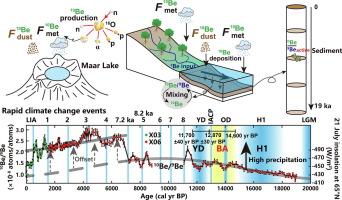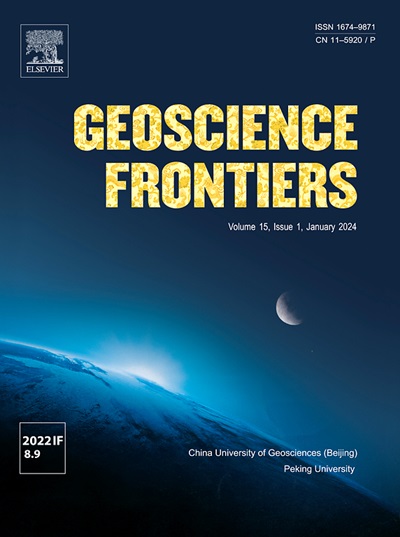马尔湖沉积物中的铍同位素对末次冰期以来快速气候变化的响应
IF 8.9
1区 地球科学
Q1 GEOSCIENCES, MULTIDISCIPLINARY
引用次数: 0
摘要
东亚地区自末次冰消期以来快速气候变化的时间、幅度和机制仍然难以捉摸。本研究利用中国东北小型水文封闭盆地小龙湾马尔湖年际层状沉积物的高分辨率铍同位素和主要元素记录,为研究东亚气候变率提供了新的视角。Al/Mg、Ca/Mg和Ti/Mg比值的突然增加表明,在b ølling- allero ød间冰期和全新世早中期,风沙输入增强,与东亚夏季风降水增强同步。结合以往的沙尘来源分析,我们推断了春季至初夏季风降雨高峰之前,中亚沙漠的西南风沙尘输送的季节性模式。10Be/9Be记录显示急剧下降,与北大西洋Dansgaard-Oeschger和Bond事件的时间密切相关。光谱分析显示10Be/9Be记录具有~ 1700年的周期性,与北大西洋观测到的千年尺度变化一致。这些发现突出了东亚和北大西洋之间持续的气候遥相关,并表明马尔湖沉积物中耦合的沙尘和水文气候信号可以可靠地跟踪亚轨道气候变率。本文章由计算机程序翻译,如有差异,请以英文原文为准。

Beryllium isotopes in maar lake sediments respond to rapid climate change since the last deglaciation
The timing, amplitude, and mechanisms of rapid climate changes since the last deglaciation remain elusive in East Asia. In this study, high–resolution beryllium isotope and major element records from the annually laminated sediments of maar lake Xiaolongwan—a small, hydrologically closed basin with homogeneous lithology in northeastern China—offer new insights into East Asian climate variability. Abrupt increases in Al/Mg, Ca/Mg, and Ti/Mg ratios indicate intensified aeolian dust input at the onset of the Bølling-Allerød interstadial and the Early–Mid Holocene, synchronous with enhanced East Asian summer monsoon precipitation. Combined with previous dust provenance analyses, we infer a seasonal pattern of dust transport from the Central Asian deserts by southwesterly winds in spring to early summer, prior to peak monsoon rainfall. The 10Be/9Be record exhibits sharp declines that correspond closely to the timing of Dansgaard-Oeschger and Bond events in the North Atlantic. Spectral analysis reveals ∼ 1700-yr periodicity in the 10Be/9Be record, consistent with millennial-scale variability observed in the North Atlantic. These findings highlight a persistent climate teleconnection between East Asia and the North Atlantic and demonstrate that coupled dust and hydroclimate signals in maar lake sediments can reliably track sub-orbital climate variability.
求助全文
通过发布文献求助,成功后即可免费获取论文全文。
去求助
来源期刊

Geoscience frontiers
Earth and Planetary Sciences-General Earth and Planetary Sciences
CiteScore
17.80
自引率
3.40%
发文量
147
审稿时长
35 days
期刊介绍:
Geoscience Frontiers (GSF) is the Journal of China University of Geosciences (Beijing) and Peking University. It publishes peer-reviewed research articles and reviews in interdisciplinary fields of Earth and Planetary Sciences. GSF covers various research areas including petrology and geochemistry, lithospheric architecture and mantle dynamics, global tectonics, economic geology and fuel exploration, geophysics, stratigraphy and paleontology, environmental and engineering geology, astrogeology, and the nexus of resources-energy-emissions-climate under Sustainable Development Goals. The journal aims to bridge innovative, provocative, and challenging concepts and models in these fields, providing insights on correlations and evolution.
 求助内容:
求助内容: 应助结果提醒方式:
应助结果提醒方式:


